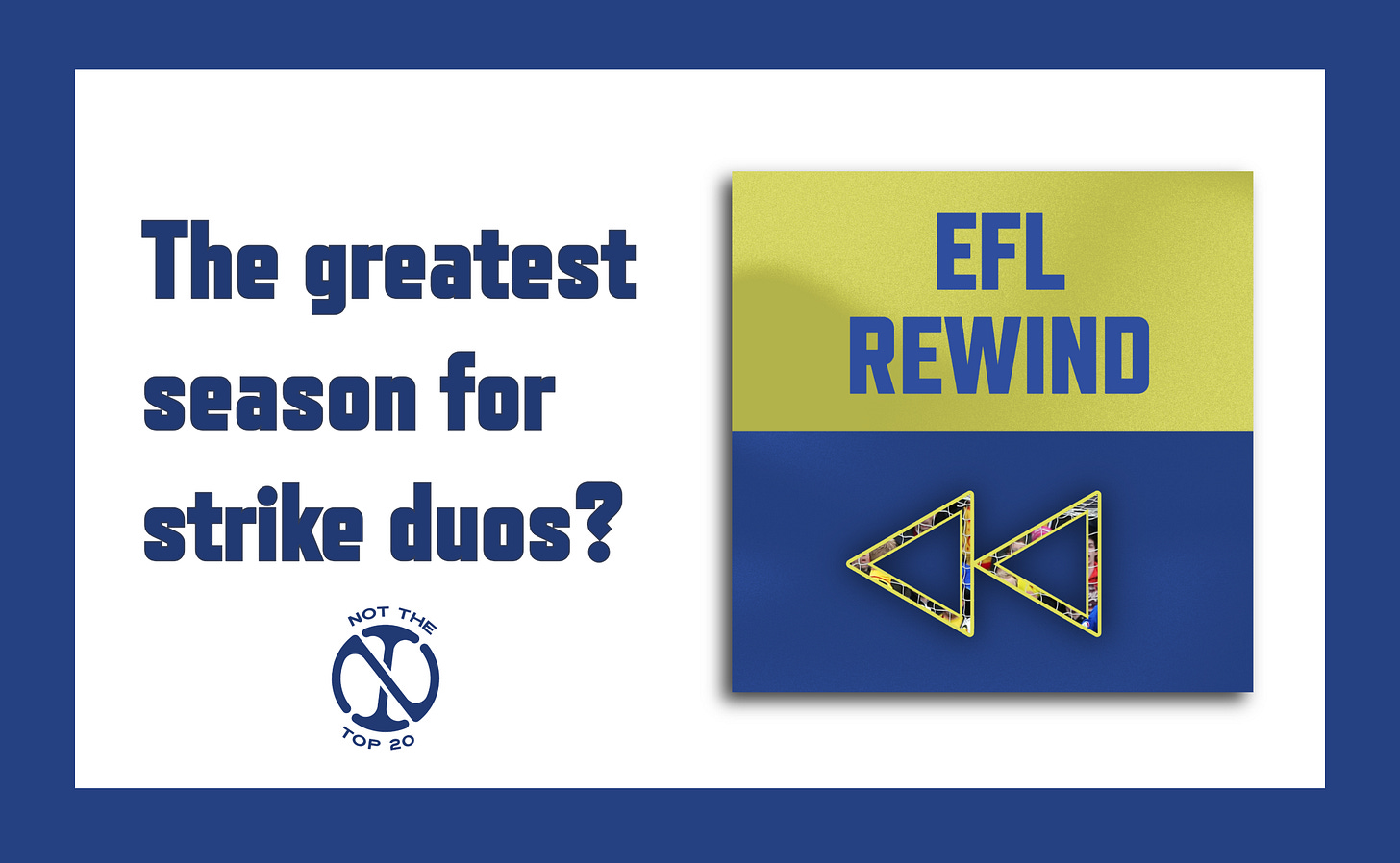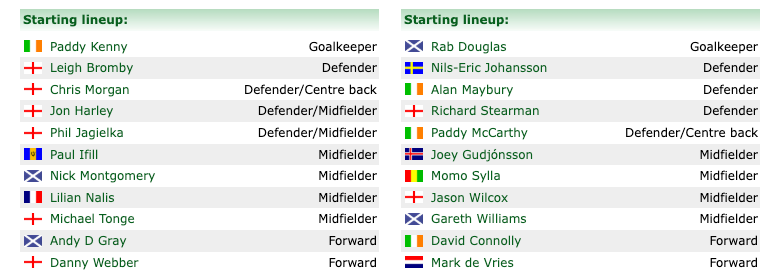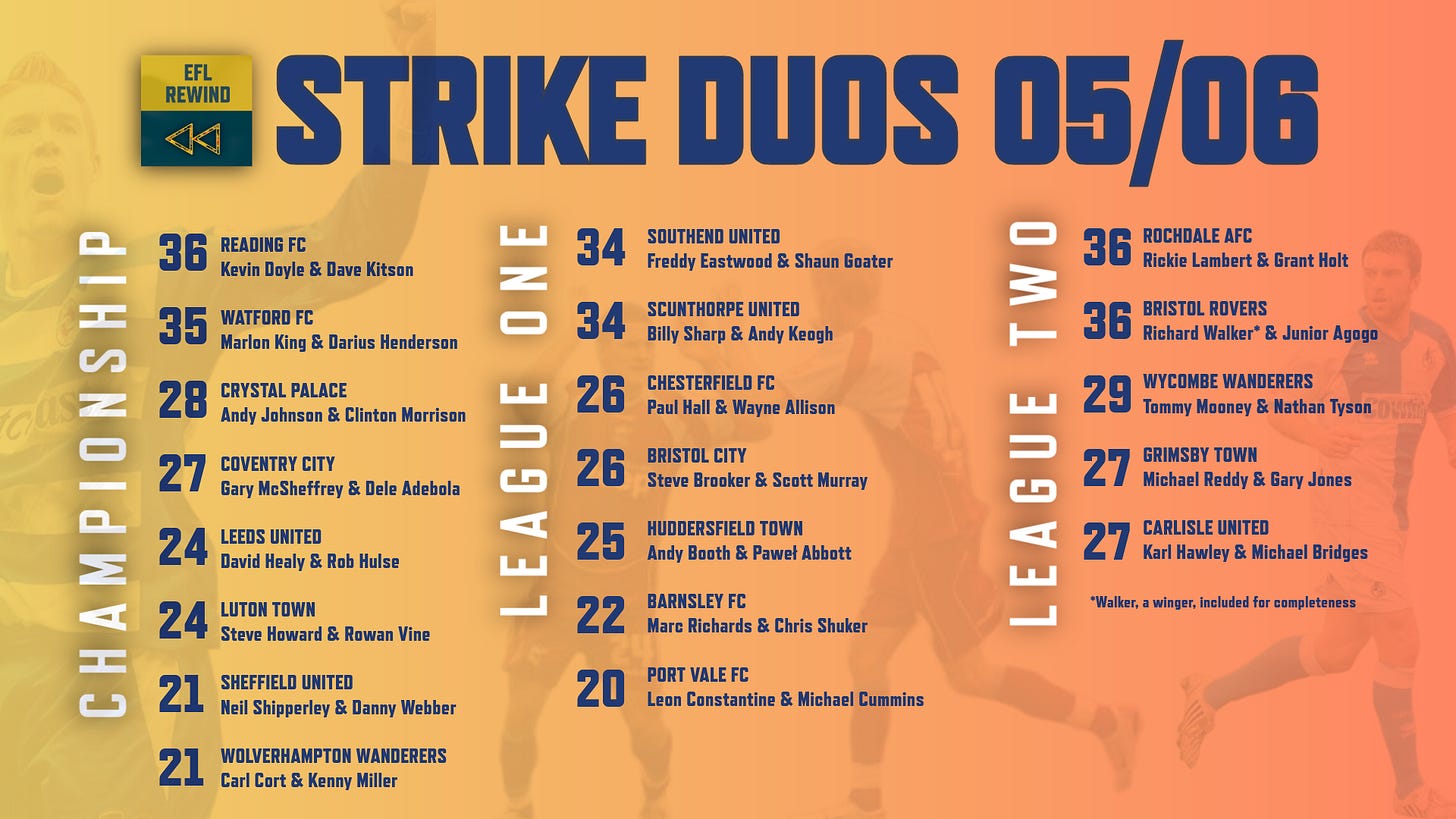⏪ EFL Rewind | The greatest season for strike duos?
It was the best of times, it was the worst of times, it was the age of Hayter, it was the age of Trundle, it was the epoch of Ling, it was the epoch of Þórðars, it was the season of 2005/06...
2005/06 was the greatest season for strike duos. If it wasn’t, tell me what was…
Hello, a new regular column starts here! Welcome to EFL Rewind.
The 2005/06 EFL season is already nailed to the honours board thanks to Reading’s Championship record of 106 points. Time was kind to the Royals – kinder than it is now.
Time was kind, too, to the Blades, Hornets, Shrimpers, Mariners, Tykes, Cumbrians, Cobblers, O’s and U’s (Colchester). It was crueller to the Railwaymen, Lions, Seagulls, Dons, Robins, Diamonds, Monkey Hangers, Saddlers and U’s (Oxford).
I include these ungainly lists for a reason. The brain does not like them. It wants symmetry. It is drawn to two. Say, Kitson & Doyle (36).
Two has duality. Two implies connection. In football, as in all things, a duo feels human simply by existing. And in 05/06, the EFL was full of them.
When the first ball was kicked that August lunchtime at Bramall Lane, Sheffield United against Leicester, both sides were stacked with names of yore.
Back then, you could still smoke in pubs. After a 4-1 win, revelling Blades fans probably reached into their pockets for old friends Benson & Hedges (10) or Lambert & Butler (20).
By the season’s end, the smoking ban had arrived. The air was cleaner, your clothes didn’t stink, and on pub screens new partnerships lit up the air: Lambert & Holt (36).
Among all on-pitch relationships, none lodge in memory quite like strike partnerships. Tactics, especially the loneliness of the long-played single striker, have thinned their number. A solitary forward can be great, of course. Mitrović’s 43 for Fulham in 21/22 proved the power of one. But the lone striker, like the lone wolf or lone operative, becomes an antagonist in the neutral imagination. Two never do.
One of the enduring images in our collective football memory is the double-pronged attack. EFL duos have rarely more prolific than Ings (21) and Vokes (20) for Burnley in 13/14, nor more frightening than Deeney (21) and Ighalo (20) for Watford in 14/15, though their teammate Vydra (16) made it three and somehow three is less romantic.
Why? Because three is the smallest number our brains need to find order and rhythm. Advertisers know this: Just Do It. Commentators know it, too: “Pique climbed high, but Dzyuba climbed higher and Russia as a nation rose highest” (Peter Drury).
Three is powerful. History even edits itself to threes. Churchill said, “blood, toil, sweat and tears” and yet we remember only “blood, sweat and tears”.
But three is also cold. Lists and patterns lack what two has in spades: personality. Two is a couple. And in 05/06, the couples did plenty of banging around the EFL’s Love Islands.
I remember them in highlight reels of the mind: the bulk of Keogh and the nous of Sharp; the hulking Howard with the then-sprightly Vine; Wayne Allison’s flicks; Palace’s prowlers, Johnson and Morrison; Eastwood firing home, on TV and FM05.
Football Manager is a neat digression. It reminds us why strikers, not defenders or goalkeepers, linger longest. We feared them or wished they played for us.
And what made 05/06 special was not just the output – it was how every division teemed with partnerships. When they came to town, with our lips puckered around a pie and hands heated around a Bovril, ears pricked as the duos’ names were read out.
A typography of 05/06 duos
Big man / Little Man
Description:
The timeless EFL pairing. One contends with the shock and awe of the aerial assault and the other makes virtue within the chaos. You have your target man and your man to find the target.
Archetypes:
Billy Sharp (23) & Andy Keogh (11) — Scunthorpe, League One
This young partnership had a hand in EFL history. Keogh would become one of the great EFL foils, while Sharp would become the leading goalscorer of the EFL era.
Marlon King (21) & Darius Henderson (14) — Wolves, Championship
There isn’t a nostalgic bone in my body for Marlon King, but this partnership crystallises, perhaps more than any other pair in 05/06, the picture of goal threat through little ‘n’ large.
See also:
Wayne Allison & Paul Hall (Chesterfield)
Gary McSheffrey & Dele Adebola (Coventry)
Rob Hulse & David Healy (Leeds)
Steve Howard & Rowan Vine (Luton)
Neil Shipperley & Danny Webber (Sheffield United)
2. Rivals
Description:
Two strikers cut from the same instinctive goalscoring cloth. Neither content to play second fiddle. Their symbiosis has a whiff of the competitive streak.
Archetypes:
Dave Kitson (18) & Kevin Doyle — Reading, Championship
The primary charges to dispense the chances created by the likes of Little, Convey, Shorey and Murty, both strikers were primarily chance-takers, even if one was littler and the other larger.
Freddy Eastwood (23) & Shaun Goater (11) — Southend, League One
Two finishers, one at the start of their career and one towards the end, Eastwood the padawan and Goater the Jedi master. It was a memorable duo in a single season of successful striking mentorship.
Rickie Lambert (22) & Grant Holt (14) — Rochdale, League Two
A big man / big man partnership. Two strikers who would play in the Premier League, but only would one retire from football to find employment in professional wrestling (Holt).
See also:
Nathan Tyson & Tommy Mooney (Wycombe)
Marc Richards & Chris Shuker (Port Vale)
A two-strong taxonomy is hardly robust, but that is the point. Nostalgia is meant to be wonky. 2005/06 may not objectively be the greatest season for strike duos, but it feels like it, and feeling is what keeps us coming back.
That’s why my advice to the managers of today would be this: If you want your fans to love your team, play two up front.
More than a tactic
Today, two up front as a tactic may be madness. As a long-term strategy it’s probably madness, too. But when I see Cheek & Kabamba for Bromley, Mellon & Quigley for Oldham, or Burrell & Kone for QPR, there’s a pang of jealousy that gets in where water can’t.
Something in the brain loves a duo. There is nothing as thrilling or romantic as a pair with chemistry. One up front is efficient but clinical. Three is never really a three and it has been done, as Andy Gray might put it, “time and time and time again”.
Two just feels right. There is something mythic about a partnership; something iconic in the truest sense. The brain loves yin and yang, day and night, Keogh and Sharp.
My memory always rewinds to 05/06 and this rewinding is not simply nostalgic but scientific. It’s because of the duos. It’s because of two. And it’s why, across the pantheon of great commentary, the mind finds Kenneth Wolstenholme stickier than Drury or Gray.
“They think it’s all over. It is now.”
Not quite the end, of course. Missing are the first part of the list of three (“Some people are on the pitch!”) and the last of four (“It’s four!”). But there’s a reason we remember it as two. Because two is what sticks. Two, arguably, is true love.






Perfect level of nostalgia to start a Friday, great read Sam!